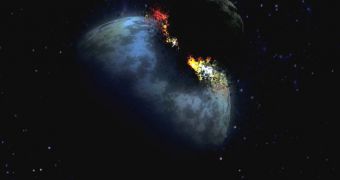According to the results of a new scientific investigation, it would appear that precious chemical elements were brought to the Earth, Moon, Mars, and potentially other places in the solar system as well, by massive collisions between space bodies.
Astronomers now generally agree that the Moon was formed after a two Mars-sized objects slammed into each other. The blast formed the Earth and its natural satellite. But another collision may have also taken place.
They say that an object about the size of the dwarf planet Pluto may have slammed into the Earth after the Moon was formed. At around the same time, other collisions took place on Mars and the Moon.
Those impacts were of smaller intensity than the one that affected our planet, but still tremendously intense, researchers behind the new investigation say.
The experts say that the effects this impact had on our planet were multiple. For starters, it may have knocked it off its axis by as much as 10 degrees, but it may have also brought chemicals such as gold and platinum to the planet.
On the Moon, similar impacts may have delivered significant quantities of water. Once though to be a barren desert, the natural satellite has over the past couple of years been proven to contain large amounts of water.
“We can use this information to tell us about the last great growth spurt of the Earth, Moon and Mars,” explains expert Bill Bottke, who holds an appointment at the Boulder, Colorado-based Southwest Research Institute (SwRI).
The investigator, who was also the leader of the new study, says that siderophile elements, which include platinum, gold and palladium are strongly attracted to iron.
This means that, under natural circumstances, they migrate towards the solid inner core of the Earth, which is believed to be made up mostly of iron. This movement left the mantles and crusts of the three celestial bodies devoid of such elements.
But studies show siderophiles can be found in the mantle and crust of Earth regardless, and in significant amounts. “The abundance of these elements is actually surprisingly high,” Bottke says.
“People have wondered, 'How can this be?' They've been arguing about it for decades,” he adds. The new study, which appears in the December 9 online issue of the top journal Science, has the answers.
It basically holds that these elements were replenished after the core of the Earth, Mars and Moon formed. The way to explain this is by proposing that space impacts occurred after the bodies and their respective core solidified, Space reports.

 14 DAY TRIAL //
14 DAY TRIAL //